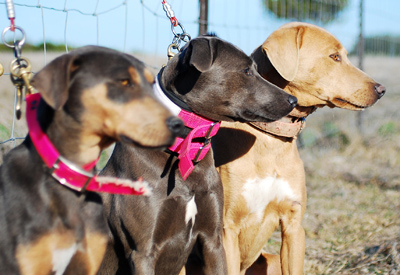| |
|
| |
During the late 19th century the Lacy brothers established a special line of dogs to gather the family's free roaming hogs and drive them from the Texas Hill Country to livestock markets in Austin. By crossing an English Shepherd with a Greyhound and a wolf, they created a fast herding dog with intense prey drive. This unique mix was developed into an all-around working breed for ranchers, cowboys, hunters and trappers. Medium in size with great endurance and grit, Lacys embodies the rugged and tenacious spirit necessary for survival on the Texas frontier.
Temperament
Intelligent, intense, active and always alert, Lacys have an incredible drive and determination to work. Their strong heading, baying and tracking instincts make them ideal for herding, hunting, working trap lines and blood trailing. Lacys are extremely smart and can be quickly trained to do numerous tasks, making them excellent prospects for agility and flyball. They are also naturally territorial and will protect their property from strangers. These dogs are very energetic and require lots of mental and physical exercise. Lacys need room to run as well as a challenging job to keep their minds occupied. Though they can make dedicated companions, this breed requires a strong leader and may not be appropriate for new dog owners or families with young children.
|
|
 The Lacy Dog was recognized as the
The Lacy Dog was recognized as the
State Dog of Texas in 2005. |
Conformation
Form follows function for these true working dogs. Strong and balanced, Lacys should be 18 to 21 inches tall and weigh between 30 and 50 pounds. They have a level back and deep chest that extends into well-sprung ribs to provide plenty of lung space. The front shoulders should be well laid back and muscular while the haunches have a tight, slightly rounded croup. Their legs are straight and medium in length with firm, cat-like feet. Correct Lacy movement alludes to speed, strength and dexterity.
For more detailed information on how a Lacy Dog should look and act, see the Lacy Breed Standard.
Appearance
In addition to the famous blue Lacys, the breed also comes in red and tricolor. Blues are any shade of gray from light silver to dark charcoal, reds range from light cream to rust and the tri combines these colors with a blue base and distinct red markings as appropriate for trim. Lacys do not carry a "rare blue gene," rather they carry a dilute dd gene that creates their color. White can appear on the brisket and one or more paws, but excessive white is discouraged and markings on the face or above the mid-line are a disqualifying fault. Their coat should be short and sleek. Lacy eyes are sharp and bright, ranging in color from bright yellow to rich brown. Their gaze is said to be similar to a wolf's in intensity.
Historical Lacy Dog Documents
Llano County, Texas, Ranchmen, Who Profit from Wild Range Hogs, Depend on Acorns and Their Hog Dogs
Article and photos by Sam E. Harris
This piece, published in the February 1956 issue of True West Magazine, outlines the origins and working history of the breed. Includes interviews with Ed Lacy and ranchers who relied on Lacy Dogs for their livelihood. "My dog is worth the pay of ten men. Last year I gathered seventy head of fat hogs with my Lacy dog. So you see that dog was worth $3,000 to me in one season." Read the True West article |
Hog Dogs and Their Ranch Uses
Article and photos by Hazel Oatman Bowman
Printed in the May 1942 Cattleman, this is the oldest published document featuring Lacy Dogs. It paints a vivid picture of the gritty working dogs that were the foundation of the breed. "Indeed to many, a Lacy and a hog dog are one and the same. Kinley Murchison, who describes the Lacy simply as a good breed of stock dog, says, 'People call a dog a Lacy if he looks at a hog!" Read the True West article |
The Saga of the Original Lacy Hog Dog
Letter written by Helen Lacy Gibbs, granddaughter of George Lacy
"After arriving, George and his brothers developed a breed of dog known as the Lacy Hog Dog... These dogs are working animals and are never happier than when working stock." Read Helen Gibbs' letter
|
Animal Research Foundation - The First Lacy Registry
Article and description from the ARF
The first studbook for Lacys was opened in 1976 by Tom Stodghill through his highly respected Animal Research Foundation. The ARF's description of the breed asserts "the style of work of the Texas Lacy Cowdog is identical to that of the Catahoula Leopard. Texas Lacys trail, find and bay wild cattle and wild hogs. They are also used for hunting raccoons, squirrels and all kinds of wild animals. They are very fast, calm and fearless." Read about the original Lacy Dog registry
|
|
|
|
|
|








